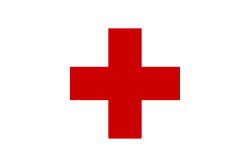Lebanese Red Cross
|
Flag of the Red Cross | |
| Formation | 1945 |
|---|---|
| Type | NGO |
| Legal status | foundation |
| Purpose | humanitarian |
| Headquarters | Beirut |
Region served | Lebanon |
Budget | CHF 7.1 million (2000) [1] |
| Website | www.redcross.org.lb |
The Lebanese Red Cross (LRC) (Arabic: الصليب الأحمر اللبناني al-Ṣalīb al-aḥmar al-lubnānī) is a humanitarian organization and an auxiliary team to the medical service of the Lebanese Army. Its headquarters is in the Lebanese capital city of Beirut. Founded in 1945, the organization comprises a number of approximately 7,000 members/volunteers and 200 staff personnel. The society works with the International Federation and the ICRC, and on a bilateral basis with the Norwegian and the French Red Cross. The LRC also works with the relevant components of the Lebanese authorities, with UN agencies and NGOs.[1]
History
The LRC was established on July 9, 1945 as an independent national society. A year later, it was recognized by the State as a public non-profit organization and as an auxiliary team to the medical service of the Lebanese Army. In 1947, it joined the International Red Cross and Red Crescent Movement which has today affiliates in 175 countries and became a member of the International Federation of Red Cross and Red Crescent Societies ever since. In addition, the LRC is a founding member of the Secretariat General of the Organization of the Arab Red Crescent and Red Cross Societies.
After the Lebanese Civil War period, the LRC had to reposition its services towards postwar requirements. In 1993, the society established a long-term development plan leading up to 2000, and an extension plan in 2002 (to cover the period up until 2005).[2]
Mission
| |||||||||||||||||||||||
